View of Delft
c. 1660–1663Oil on canvas
98.5 x 117.5 cm. (38 3/4 x 46 1/4 in.)
Mauritshuis, The Hague
Vermeer's magnificent townscape of Delft seen from the south has always been regarded as one of his masterpieces. In the 1696 auction of Dissius's 21 Vermeer's, it was the most expensive picture, fetching 200 guilders. In 1822 the picture was bought by the Mauritshuis for the high price of 2,900 guilders, a purchase said to have been instigated by the Dutch King, Willem I. In the mid-nineteenth century View of Delft was the painting which inspired the French critic Théophile Thoré to rediscover Vermeer.
The picture is divided into four horizontal bands: the quay, the water, the town and the sky. On the left side of the quay are a mother and baby, and two fashionably dressed men and a woman talking together, and further towards the centre are two more women. The water represents a section of the River Schie, which eventually flows into the Rhine at Schiedam, near Rotterdam. The area of river depicted by Vermeer had been widened in 1614 to form a triangular pool which served as the harbor for Delft. Looking towards the town, the view is dominated by the ramparts and the Schiedam and Rotterdam Gates. The distant tower of the Old Church (fig. 1) can only just be seen on the horizon on the left of the picture. Most of the town is in shadow, except for the sunlit New Church (fig. 2). The dramatic morning sky takes up over half of the picture; a tiny clock on the Schiedam Gate shows that it is just past 7 o'clock.
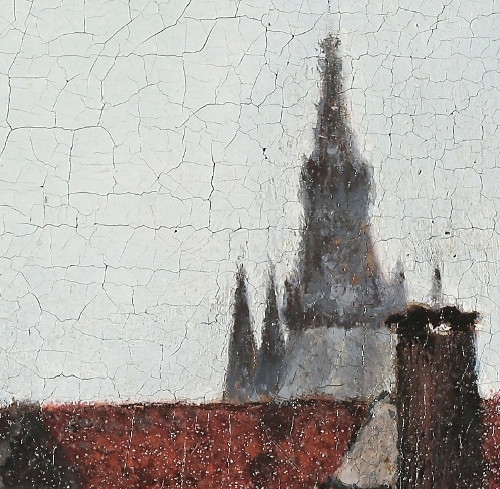
Johannes Vermeer
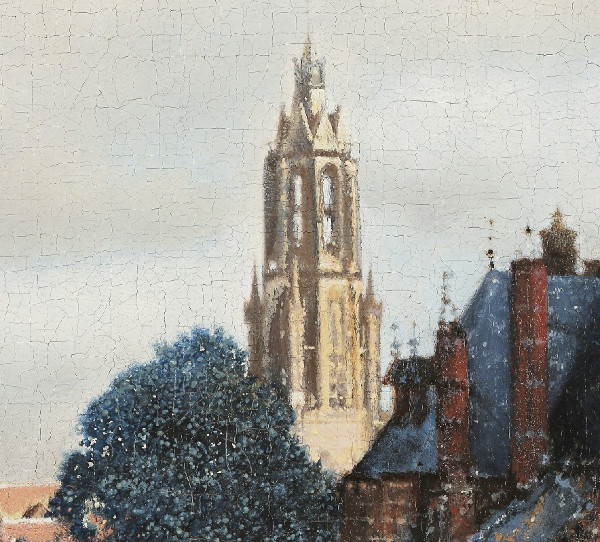
Johannes Vermeer
The view is from an elevated position, looking down onto the waterfront, and Vermeer may have painted the town from the upper floor of a house that is marked on contemporary maps just off the road named Hooikade. The pointillist technique that Vermeer used to suggest reflections flickering off the water, most easily visible on the two herring boats on the right, is evidence that he probably used a camera obscura to help compose the picture; diffused highlights such as these would appear when a partially focused image was obtained from this device.
The meticulous way that Vermeer worked on this masterpiece is shown by the fact that he mixed grains of sand (fig. 5) into some of his paint to achieve a certain texture. An examination of the picture has revealed that the sand was added to the ochre used on the window frames of the long building to the left, behind the ramparts, giving a greater reflective quality to the paint surface.
View of Delft shows the ramparts and the two fourteenth-century gates on either side of the stone bridge spanning the canal that passes through the town; on the far side of the bridge the water divides to become the Oude Delft and Nieuwe Delft canals. The Schiedam Gate with the clock-tower is on the left of the stone bridge and to the right is the Rotterdam Gate. Vermeer's home, Maria Thins's house in Oude Langendijk, would be just to the right of the tower of the New Church, although it is not visible in this picture.

Abraham Rademaker
1700–1710
Drawing and wash, 66 x 106 cm.
Stedelijk Museum Het Prinsenhof, Delft
Despite the impression of accuracy which the painting gives, Vermeer did not make a precise representation of the view. In a topographical drawing (fig. 3) by Abraham Rademeker (1675–1735), executed about half a century later from a similar vantage point (fig. 4), it is noticeable that the buildings appear taller and crammed closer together than in Vermeer's picture. Vermeer seems to have shifted the buildings slightly to produce a more harmonious composition and this is most noticeable in the way he depicted the long section of the Rotterdam Gate.
Today the view from Vermeer's vantage point looks quite different, although the shape of the old harbor remains. The town's ramparts have long gone and the two gates were demolished between 1834 and 1836. Most of the medieval buildings near this part of the river have also been lost. The spire of the New Church burned down in 1872 and was replaced by a taller neo-gothic one. The original tower of the Old Church survives, although it has now developed a pronounced tilt.
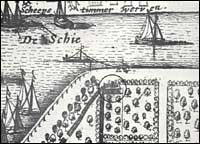
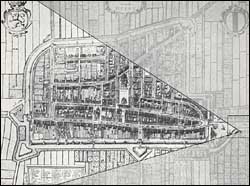

Johannes Vermeer
c. 1660–1663
Oil on canvas, 98.5 x 117.5 cm.
Mauritshuis, The Hague

Mariët Westermann
"Vermeer and the Interior Imagination"Vermeer and the Dutch Interior
2003, p. 219
Vermeer's View Delft is probably the most memorable cityscape in western art. Though not an interior scene, as most works by Vermeer are, the painting draws us into his mental and social world: into his artistic vision and into his city. What we see seems almost too obvious, too plainly descriptive, too perfectly observed to require comment or analysis: the city of Delft appears before us under the partial clouds characteristic of the North Sea climate, a palpable grouping of brick, mortar, and clay structures seen across the broad Schie canal. It is all there, still nameable today: the Schiedam gate at left, the Rotterdam gate with its twinned turrets at right, the tower of the Nieuwe Kerk, or New Church, picked out in the brightest sunlight, the diminutive tower of the Oude Kerk, or Old Church, just breaking the long roofline at left. The scene's varied light effects look so natural—deep shadow and bright patches, pinpoint highlights and watery reflections—that the eye ignores what the mind knows: that this light is high artifice, that it is a work of painting.

Johannes Vermeer
c. 1660–1663
Oil on canvas, 98.5 x 117.5 cm.
Mauritshuis, The Hague
Despite the unusualness of this exterior scene within Vermeer's production, it has, for many modern viewers, come to stand for Vermeer himself. When Marcel Proust needed an image for artistic perfection he chose the patch of yellow that, in Vermeer's curious vision, wedges a splendid sun-drenched roof between shaded walls (fig. 6). How could the View of Delft become an epitome of artistry in western culture? Some answers to this question tell us more about the novel and self-aware character of Vermeer's art, which is so central to the continuing appeal of his interior painting.
Art historians have traced various precedents for Vermeer's direct rendition of the city from the south side, and the painting unquestionably acknowledges this genealogy. Vermeer knew the descriptive profile views of cities that appeared in historical descriptions of cities. Such views were often printed alongside the edges of city maps, and Vermeer included a wall map of this kind in The Art of Painting. He also must have known paintings of cities seen in profile against a low horizon. Yet unlike the cityscapes Vermeer found before him, View of Delft does not amount to a somewhat clinical, dry inventory of the local architectural scene. There is an unprecedented immediacy and tangibility about Vermeer's Delft.
Much accounts for the difference the View of Delft makes. Crucial is the framing, which cuts off the view to left and right at seemingly arbitrary points. Eyes trained on photography accept such slicing, but it must have been startling to contemporaries. This move brings the city closer, makes it loom large. Another tactic that makes the city seem monumental yet near is the remarkably high key of the coloring of distant architectural features. While the colors are limited in range, their intense saturation is surprising given the presumed distance at which the city is seen. And then there is the strong composition of the painting into broad but loose horizontal bands of light and dark, unobtrusive at first. Insistent patterns also arise from Vermeer's judicious distribution of sunlight and shadow, and from his emphasis on dark foreground clouds and dark reflections in the water.
The result is an arresting monument to Delft and its historical place, signaled subtly by the sunlit aspect of the tower of the Nieuwe Kerk. This church had gained fame in the seventeenth century as the location of the tomb of William of Orange (fig. 7), the sixteenth-century prince who had led the Northern Netherlands in their revolt against Spanish governance. The Father of the Fatherland, as he became known, had chosen Delft as his residence, and it was there, in 1584, that a political adversary assassinated him.

Hendrick de Keyser and Hendrick's son, Pieter 1614–1620
Marble and bronze, height 7.65 m.
Nieuwe Kerk, Delft
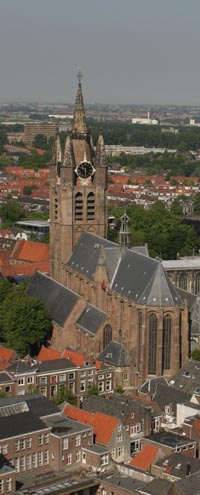
Most Delft contemporaries would have recognized Vermeer's emphasis on the tower, in marked contrast to the diminutive presence of the tower of the Oude Kerk, And yet View of Delft is no Orangist propaganda piece, for the image subsumes the venerable and complex history referenced by the tower into an image that looks contingent on an immediate atmospheric moment. Most of Vermeer's paintings derive their fascination from such a tension between acute momentary observation (registered in accidents of lighting or human actions) and a sense that the resulting image freezes a moment in a narrative history.
Vermeer included about 15 figures in his painting (fig. 8). The costumes of the six figures in
the foreground designate their social standing, from the fashionable attire of the three burgers standing by the boat, to the simpler regional or peasant garment of black skirts and jackets with white collars and shoulder clothes of the other women. A figure of a man just to the right of the two women was painted out by Vermeer.
The six figures in the foreground are shown in the detail of the painting below.
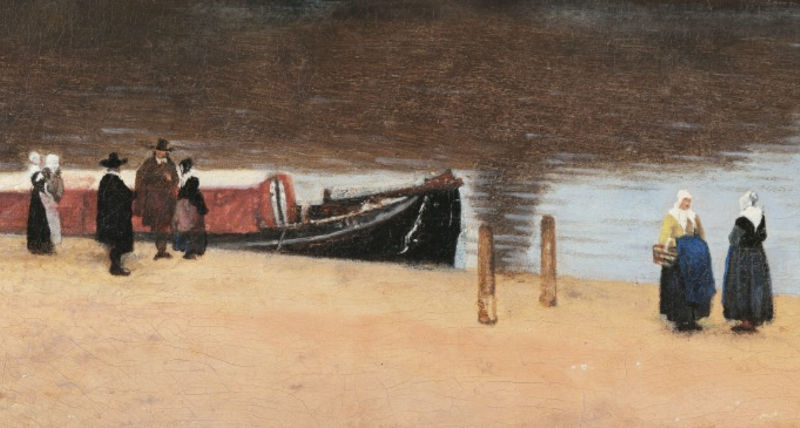 fig. xx >fig. 8 View of Delft (detail)
fig. xx >fig. 8 View of Delft (detail)Johannes Vermeer
c. 1660–1663
Oil on canvas, 98.5 x 117.5 cm.
Mauritshuis, The Hague
The great View of Delft by Jan Vermeer, now in the Mauritshuis, The Hague, the first of his paintings to enter a public collection, is unique among his known works. The canvas known as The little street [Het Straatje], in the Rijksmuseum, and a lost piece recorded as "A view of some houses" are the only other exteriors. The Little street is a small work, little more than a fifth the size of the View of Delft, and the lost work is unlikely to have been larger. But the View of Delft (98.5 x 117.5 cm.) is almost the largest picture the mature Vermeer ever painted.
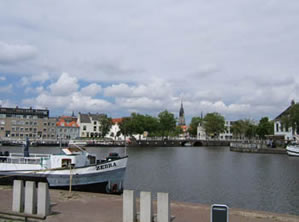 fig. xx >A photograph taken from approximately the point
fig. xx >A photograph taken from approximately the pointwhere Vermeer placed himself to paint his
View of Delft as the scene
appears today.
Photograph courtesy of Adelheid Rech
It is not a landscape in the contemporary manner. That is, it is not a pictorial invention with a rural motif. It is a topographical view of the town, apparently giving an accurate record of its appearance from the south as it was in the early 1660s. Prominent, immediately across the river Schie, are two of the city's gates, the Schiedam gate on the left and the Rotterdam gate on the right. In the distance, above the roof-tops can be seen the towers of the Oude Kerk (Old Church) on the left and the Nieuwe Kerk (New Church) to the right. So vivid and distinctive is the impression of visual accuracy given by the painting, that it has been suggested that despite its considerable scale and the novelty and impracticability of the procedure at the time, it must have been painted on the spot, directly from observation, rather than in the studio after drawings. The discovery on a map of Delft published in 1649 that on the bank of the river Schie among gardens and open land is a solitary building at exactly the spot where the artist would have needed to work has given credibility to the hypothesis. It has even been proposed that the building could have, at least temporarily, housed a camera obscura. This optical device would have projected an image of the town on to a screen. By its aid, Vermeer could have achieved the precise perspective his painting exhibits and also certain curious optical effects that are unique to his work. For what strikes the viewer of the painting itself is its total difference from the topographical pieces of Gerrit Berckheyde or Jan van der Heyden or others. They show every brick and minute feature of the scene. Vermeer establishes the scene as viewed from a distance. And he achieves this by brilliant optical and painterly inventions that can only have been developed in front of the subject.
Topography is a branch of geography and by the second half of the seventeenth century topographical representations were of two principal types. There was the bird's-eye view, which provided a quasi-map and called for considerable inventive ingenuity from the artist, and there was the panoramic profile. Among the earliest of the latter is an anonymous woodcut View of Antwerp (fig. 9) of 1515. This already has the format adopted by later topographers. The town is presented as a frieze of architectural elevations with a narrow band of sky (cluttered with inscribed cartouches, escutcheons and allegorical figures) above and below the river busy with maritime traffic, and the near bank of the river appears as a narrow strip along the bottom edge. In paper prints the scroll format is attractive, in paintings it is less so. Yet in the flat Netherlands, it was hard to avoid. When the draughtsman was at the distance necessary to view the full extent of the town it became on his drawing paper a narrow ribbon spiked with towers. So the majority of painted topographical views of towns are cast in the narrow extended form of the topographical print. This is true of two views of Delft that Vermeer must have known. These were both by Hendrick Vroom and both are now in the Delft Stedelijk Museum "Het Prinsenhof." There is a View of Delft from the west of 1615 and a View of Delft from the north-west dated 1617. In area, these canvases are only slightly smaller than Vermeer's painting but their proportions are very different, both aver twice as wide as they are high, approximating 71 x 160 cm. Both show the full extent of Delft as seen from its chosen direction. In both cases the town is reduced to a narrow band above which are the towers of the two churches and the Prinsenhof project. In both, though, the town is shown in profile, and the view of the foreground is from an unexplained lofty vantage point.
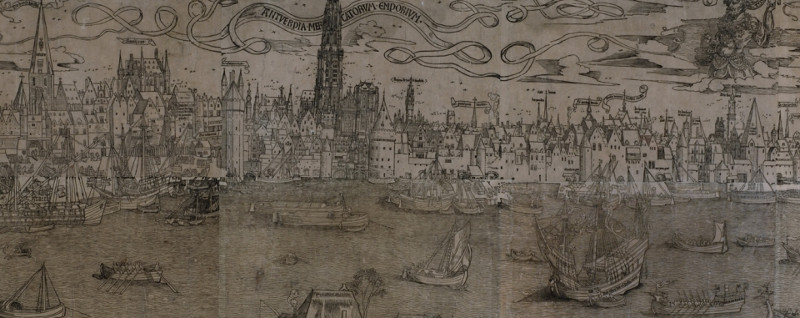 fig. xx fig. 9 View of Antwerp
fig. xx fig. 9 View of Antwerp Anonymous
1515
Woodcut in twelve blockswith: 2.2 meters
Museum Plantin-Moretus, Antwerp
* The View of Antwerp, by an anonymous mapmaker, is one of the oldest known panoramic cityscapes. The map represents a section of Antwerp: the mooring-places for the ships, the shipyard with its crane, the towers, the ramparts along the Scheldt, the main secular and religious buildings. Every building is realistically depicted, and locations are identified. Although it is dated 1515, the tower of the Church of Our Lady was not "volmaect" (completed) until 1521, but it is already there on the print, which is why some specialists have proposed the date of 1521, rahter than 1519. h The two Venetian galleys are also problematic, as shipping was suspended between Venice and Antwerp from 1508 to 1518.
The map bears a Latin inscritpion on the banderole near the Church of Our Lady, "Antwerp: the merchants' emporium." This suggests that the print was intended to highlight the citys economic importance.
*image and text from:
https://www.museumplantinmoretus.be/en/page/view-antwerp-roadstead
Against this tradition, Vermeer's invention is remarkable for its subtle ingenuity. He takes the traditional high viewpoint that divides the composition into four bands with the town spread across the picture between sky above, the river and near bank below. Indeed, he exaggerates the frieze-like aspect of the perspective. It is established and dominated by the parallel horizontals of the red roofs and wall on the left, confirmed by the four-square rectangularity of the Schiedam gate at the centre of the composition and continued to the Rotterdam gate by the bridge across the entrance to the Oude Delft canal. But it is not immediately striking that the buildings that make up the Rotterdam gate (the one with the high-pitched roof beside the bridge and the actual gate with its twin spires linked by a lower building with a long pitched roof) are at right angles to the bridge and the entire line of the waterfront on the left. Indeed, the bascule bridge that appears to the extreme right of the painting connects the gate with the near bank of the Schie. This is concealed by several devices. The horizon is level with the line of the roof linking the two main buildings of the gate, so bringing it into line with the horizontals of roof-tops and bridge. Then, again, the horizontal below the pitched roof of the rear building and the crenellated top of the gate, below its twin spires, are almost aligned with the sunlit roof visible between the two main buildings, so presenting a rectilinear unity. The impression created by these devices is furthered by a cunning use of light. Judging by the sunlit roofs and the tower in the distance, the sun appears to be behind and over the right shoulder of the viewer. This might be expected to have created a striking contrast, in the foreground, between the facades of the Schiedam gate and the main buildings of the Rotterdam gate in strong sunlight and the flank of the Rotterdam gate that should have been in deep shadow. But it appears from the clouds overhead that the foreground is overcast, and so those contrasts are reduced. A recent study of the painting by X-ray has revealed a number of small alterations, notably in the extension of the reflections, that further contribute to the impression of the town spread across the horizon apposite the viewer.
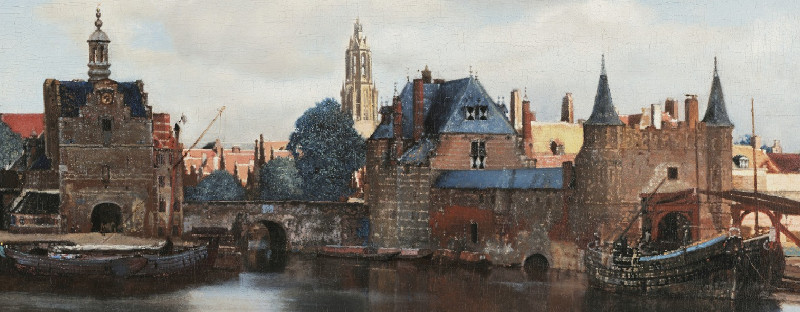
fig. xx View of Delft (detail)
Johannes Vermeer
The most appropriate position from which to represent Delft would have been, without question, that chosen by Vroom far his painting of 1615 (fig. 10). The town had grown about two long canals, the Oude Delft and its parallel Nieuwe Delft, with the Oude Kerk built between them. Despite an expansion to the east in the mid-fourteenth century, the older part of the town and the more important buildings remained extended along the lines of the original canals. From Vroom's perspective from the west, the line of the canals and, thus, of the entire town lay spread across his canvas, secure behind its defensive wall. To the extreme right can be seen the small bascule bridge that reappears to the right of Vermeer's view. In his second view, from the north-west, Vroom again embraced the entire visible expanse of the town but from a viewpoint that reversed the orientation of old and new churches.
 fig. xx fig. 10
View of Delft seen from the Southwest
fig. xx fig. 10
View of Delft seen from the SouthwestHendrick Cornelisz Vroom
c. 1615
Oil on canvas, 71 x 160 cm.
Het Prinsenhof, Delft


